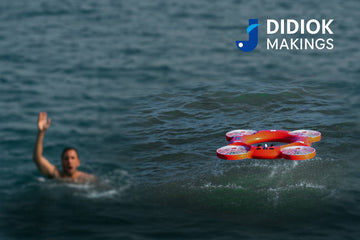When lives are on the line, the right equipment can make all the difference. Water rescue operations are evolving rapidly, and remote-controlled UAVs (Unmanned Aerial Vehicles) are quickly becoming essential tools for rescue teams worldwide. But how do you know if your team is ready to invest in one? More importantly, how do you choose the right model?
This guide breaks down the five key parameters that any department or procurement officer should evaluate before making a decision.
1. Remote Control Range
One of the first things to consider is how far the UAV can be effectively operated. In a real rescue situation, seconds matter—and you don’t want to be limited by short-range equipment. A solid UAV should have a control distance of at least 800 meters to cover rivers, reservoirs, and coastal areas.
For example, the JX-6A rescue drone supports a control range of up to 1100 meters, offering sufficient coverage even in large-scale emergencies.
2. Flight Time
Longer flight time means more ground (or water) covered and a higher chance of reaching the victim quickly. A rescue UAV should offer a minimum of 20 minutes of stable flight time under typical payload and weather conditions. This ensures that it can not only reach the target but also hover or support ongoing operations.
Make sure to ask the supplier about real-world flight time tests, not just lab results.
3. Buoyancy and Payload Capacity
A water rescue UAV isn’t just a flying camera—it must be able to assist directly in the rescue effort. This means providing buoyancy support or delivering flotation gear.
Look for units that offer at least 150N of buoyancy. The JX-6A, for example, offers 190N—sufficient to support a person in distress until further help arrives.
4. Ease of Operation
Emergencies are chaotic, and there may not be time for complex setup or control systems. A good UAV should be operable by a single person with basic training. Features like one-key return, simple directional control, and stable hovering are essential.
The JX-6A is designed with user-friendly controls, making it suitable for fire departments, coast guards, and even volunteer teams with limited technical resources.
5. Environmental Adaptability
Your drone should be able to handle more than just sunny days. Consider where it will be deployed: cold rivers, hot coastlines, rain, wind?
The JX-6A is built for demanding environments. It works between -10℃ to 55℃, is waterproof (IP68 rating), and can take off and land on water. Plus, with a wind resistance of up to level 6, it remains reliable when the weather turns bad.
Final Thoughts
Investing in a water rescue UAV isn’t about following trends—it’s about saving lives more efficiently. By focusing on these five key criteria, you’ll be better prepared to choose a model that fits your team’s needs.
If you're exploring reliable options, the JX-6A checks every box above. Feel free to reach out for more specs or demo videos—we’re happy to help you find the right fit.





